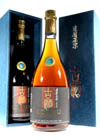The first saké on the menu was Ryusei Junmai Daiginjo (SMV: +3, Acidity: N/A, Rice: Yamadanishiki, Seimaibuai: N/A, Yeast: N/A), from Hiroshima Prefecture. I've had their Tokubetsu Junmai, and always thought it was atypical for Hiroshima saké, as it had more expression and fruit oriented rather than having a distinct earthy component like Kamoizumi or Suishin. This was very good with deep and firm fruit expression and long finish.
 Next up was Kirinzan Jumai Daiginjo (SMV: +3, Acidity: 1.3, Rice: Takanenishiki, Seimaibuai: 45%, Yeast: N/A), from Niigata Prefecture, which was very memorable for its uniquely shaped blue bottle. Initially, this was a lot like many Niigata saké with notes of steamed rice and cream with initial sweetness. However, this saké had an extraordinary long finish that slowly turned dry.
Next up was Kirinzan Jumai Daiginjo (SMV: +3, Acidity: 1.3, Rice: Takanenishiki, Seimaibuai: 45%, Yeast: N/A), from Niigata Prefecture, which was very memorable for its uniquely shaped blue bottle. Initially, this was a lot like many Niigata saké with notes of steamed rice and cream with initial sweetness. However, this saké had an extraordinary long finish that slowly turned dry. Although late lunch meant I wasn't particulary hungry, Chizuko-san gave us the seasonal menu. Not a bad idea, since we were planning on consuming quite a few more selections. We chose couple of superb dishes, including home-made tofu that uses mascarpone cheese, and the prized matsutake mushroom tempura served with salt from Okinawa.
Although late lunch meant I wasn't particulary hungry, Chizuko-san gave us the seasonal menu. Not a bad idea, since we were planning on consuming quite a few more selections. We chose couple of superb dishes, including home-made tofu that uses mascarpone cheese, and the prized matsutake mushroom tempura served with salt from Okinawa. With such fine cuisine on the way, my next choice had to be equally great. For that, I turned to Yusura Junmai Nama Ginjo (SMV: +3, Acidity: 1.3, Rice: Yamadanishiki, Seimaibuai: N/A, Yeast: N/A), by the legendary Sudo Honke ("House of Sudo") of Ibaraki Prefecture. This was the perfect choice to go with the dishes, as vibrancy of the namazaké was contrasted with the silky texture of tofu while cutting through the tempura skin. Flavor-wise, it was mostly creamy steamed rice with touch of mint and a very long finish.
With such fine cuisine on the way, my next choice had to be equally great. For that, I turned to Yusura Junmai Nama Ginjo (SMV: +3, Acidity: 1.3, Rice: Yamadanishiki, Seimaibuai: N/A, Yeast: N/A), by the legendary Sudo Honke ("House of Sudo") of Ibaraki Prefecture. This was the perfect choice to go with the dishes, as vibrancy of the namazaké was contrasted with the silky texture of tofu while cutting through the tempura skin. Flavor-wise, it was mostly creamy steamed rice with touch of mint and a very long finish. I couldn't decide what to try next. Chizuko-san gave me taste of clean and grainy Aramasa Junmai (SMV: +3, Acidity: 1.6, Rice: N/A, Seimaibuai: N/A, Yeast: Assoc #6 a.k.a. "Shinsei" or "Aramasa"), from Akita Prefecture and much richer and earthier Bandai Junmai (Data N/A), from Fukushima Prefecture, but neither really hit the spot to follow Yusura. Flipping through the extensive beeverage menu, I found a saké that I've always wanted to try: Narutotai Genshu (SMV: +2, Acidity: 1.4, Rice: Yamadanishiki, Seimaibuai: 50%, Yeast: N/A), from Tokushima Prefecture. I've had other Genshu, but this one always intrigued me for some reason. ALthough Narutotai is brewed as Yamahai in addition to being a Genshu, the theme of this saké is balance. Right off the nose, there is the Yamahai-like nose of steamed rice and nuts. On the palate, there is a gentle yet expressive steamed rice and mild fruit that leads to long, balanced, and clean finish. This is definitely one of the best Genshu I have tried.
I couldn't decide what to try next. Chizuko-san gave me taste of clean and grainy Aramasa Junmai (SMV: +3, Acidity: 1.6, Rice: N/A, Seimaibuai: N/A, Yeast: Assoc #6 a.k.a. "Shinsei" or "Aramasa"), from Akita Prefecture and much richer and earthier Bandai Junmai (Data N/A), from Fukushima Prefecture, but neither really hit the spot to follow Yusura. Flipping through the extensive beeverage menu, I found a saké that I've always wanted to try: Narutotai Genshu (SMV: +2, Acidity: 1.4, Rice: Yamadanishiki, Seimaibuai: 50%, Yeast: N/A), from Tokushima Prefecture. I've had other Genshu, but this one always intrigued me for some reason. ALthough Narutotai is brewed as Yamahai in addition to being a Genshu, the theme of this saké is balance. Right off the nose, there is the Yamahai-like nose of steamed rice and nuts. On the palate, there is a gentle yet expressive steamed rice and mild fruit that leads to long, balanced, and clean finish. This is definitely one of the best Genshu I have tried.
The last order of the night was recommended by Lefty, and it was Daruma Masamune Koshu, a multi-vintage blend of '72, '82, '84, and '94 vintages. Simply put, Koshu is Japan's answer to sherries and ports. Daruma Masamune was complex, starting with oxidized aromas of dried fruits like sherry. The flavor slowly evolved from sherry to dark chocolate before finishing with long notes of coffee and spices. This is a great study in versatility of saké, and an appropriate coda for the evening.

No comments:
Post a Comment